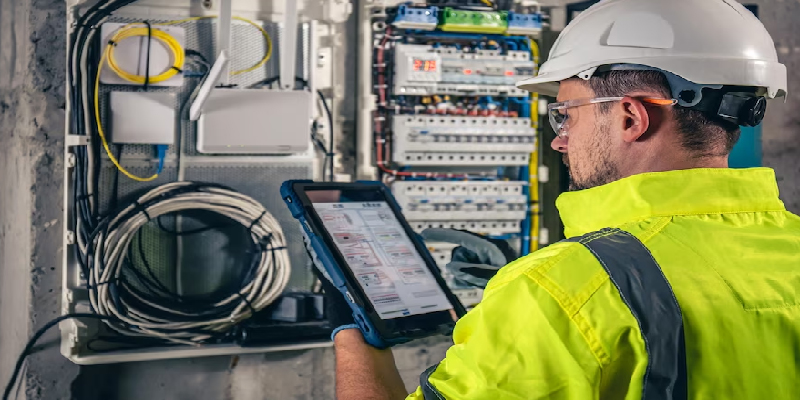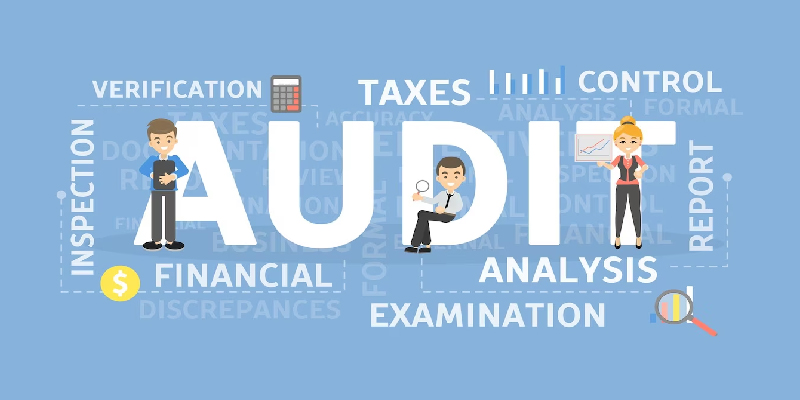A Basic Guide on Fire Safety Inspection in Healthcare Zone

October 5 , 2023
Fire safety holds huge worth in managing healthcare facilities operating under intense pressure. There is no area for fault when it comes to ensuring patient safety. From 2012 to 2014, FEMA’s National Fire Incident Reporting System (NFIRS) recorded approximately 5,700 fires in medical facilities, resulting in 25 annual injuries and five fatalities, alongside property damage amounting to about $5 million annually.
Unlike shopping malls, schools, or sports arenas, healthcare facilities house individuals who are often ill, disabled, or elderly. Consequently, facility managers bear the responsibility of retaining watchful safety measures—careful attention to detail and regular safety inspections can control and avert fires.
Now, healthcare audit app arise as a valuable tool for enhancing safety. Facility managers can, with these technological solutions, shore up their fire safety efforts.
Within this blog, we will delve into the following topics:
- exploring fire safety inspections in healthcare
- emphasizing the significance of fire safety checks in healthcare
- five key strategies for ensuring fire safety in healthcare facilities
- how auditing software solutions can streamline fire safety inspections
- why UrAudits stands out as the premier fire safety inspection software for your business
- hospital fire safety checklist
What is fire safety Inspection in the Healthcare Sector?
Fire safety inspections in healthcare pertain to assessing and enhancing fire safety measures within medical facilities. These inspections encompass evaluations of fire alarms, sprinkler systems, evacuation plans, and the overall preparedness of healthcare settings to respond to fire emergencies. It is all about the safety of patients, staff, and visitors in healthcare environments.
Importance Of Fire-safety Checks in Healthcare Sector

The impact of conducting fire safety checks in healthcare cannot be overstated. A 2013 study (NFPA performed) gives emphasis to the global concern about hospital fires and how poor hospital fire safety can cause the death of some folks in some countries. However, the United States has a notably low hospital fire fatality rate, primarily due to the rigorous adherence to NFPA codes and standards. Key among these codes are NFPA 99 and NFPA 101, which govern safety in healthcare facilities.
There are focal aspects regarding the importance of fire safety in healthcare:
- Patient Safety: Healthcare facilities often put up vulnerable individuals, like patients with limited mobility or cognitive impairments. Fire safety checks can ensure their safety during emergencies.
- Regulatory Compliance: Stringent fire safety regulations, as stipulated by organizations like the National Fire Protection Association (NFPA), necessitate strict adherence by healthcare facilities. Regular checks are imperative to maintain compliance.
- Preventing Fire Propagation: Healthcare facilities employ fire containment measures, such as fire-rated walls and doors. Fire safety checks are indispensable in verifying the effectiveness of these features, thereby thwarting the spread of fires.
- Equipment Maintenance: Hospitals and clinics house specialized medical equipment that can be sensitive to smoke and fire. Regular inspections serve to preserve the functionality of this equipment.
- Evacuation Planning: Fire safety checks can evaluate evacuation routes, you can ensure accessible pathways, and conduct evacuation drills to prepare staff and patients for unforeseen emergencies.
- Minimizing Disruption: Fires can disrupt healthcare services, placing patients at risk. Routine checks are geared towards mitigating such disruptions and sustaining uninterrupted patient care.
- Legal Liability: Ignoring fire safety checks can cause legal liabilities in the event of fire-related incidents, like lawsuits and penalties—adherence to fire safety protocols is a must to mitigate these risks.
5 Main Strategies for the Best Fire Safety in the Healthcare Sector

Here are six main strategies for strong fire safety in your healthcare:
Keep a Close Eye on Kitchens, Especially During Meal Preparation Times
Cooking equipment stands as the leading cause of fires in healthcare facilities.
The most recent industry survey by NFPA, from 2006 to 2010, indicated that 61% of fires originated in the kitchen.
Notably, a 2009 FEMA study pinpointed fire peaks aligning with kitchen staff’s meal preparation times, commencing at approximately 8 a.m. and recurring at 4 p.m.
Fortunately, these fires typically remain confined to the kitchen area, often limited to the appliance of origin.
To prevent cooking equipment-related fires in your healthcare facility, adhere to these Occupational Safety and Health Administration (OSHA) guidelines:
- Regularly empty grease traps in appliances to avert grease fires.
- Ensure the separation of flammable substances, such as oils and liquids, from cooking equipment.
- Conduct routine cleaning of grills and ducts to prevent flammable debris from gathering.
- Regularly inspect electrical cords for wear, fraying, or damage.
- Keep convenient fire extinguishers, like dry chemical extinguishers, readily accessible and ensure staff is trained.
Besides monitoring kitchens, especially during meal prep, ensuring that your staff is well-versed in your facility’s fire safety plan is crucial. In the event of a fire, employees must respond calmly and swiftly to prevent the fire from spreading beyond the kitchen.
Periodically Inspect Electrical Outlets and Wiring

Cooking fires, though frequent, tend to remain localized within a single appliance or room. Conversely, fires resulting from electrical malfunctions can have wider-reaching consequences.
FEMA’s findings revealed that one in five non-confined fires (spreading beyond their origin) resulted from damaged wiring or overloaded outlets. The primary ignition source for these fires was “general materials,” including the insulation surrounding electrical wiring.
As a healthcare facility manager, it’s imperative to recognize your facility’s electrical infrastructure. Similar to kitchen fires, electrical fires can be prevented.
Many fire departments praise lessening the usage of extension cords whenever likely. Consider relocating the appliance or installing extra outlets instead of relying on cords to connect appliances to outlets. View extension cords as temporary solutions, not permanent ones.
Keep those cords free of frays and well clear of anything flammable. Don’t let cords go under carpets, rugs, or underneath doors, walls, or windows.
Regularly ask yourself these questions concerning cords:
- Are there any cords that are frayed or cracked?
- Are cords or plugs overloaded?
- Are any plugs damaged?
- Are power cords in people’s walking paths?
One potential problem with multi-plug adaptors is that they can cause an outlet to be overloaded from having too much current coming from more than one plugged-in appliance. Electricians only can arrange, observe, and keep up the electric framework inside your office.
Strictly Prohibit Smoking in Proximity to Oxygen
Smoking within healthcare facilities, particularly near oxygen-dispensing machines, causes major risks.
While receiving oxygen, a patient tried to ignite a cigarette, leading to minor burns. The local fire department fast responded and effectively contained the fire.
This situation is particularly perilous because an increased oxygen concentration in the air can cause fires to burn more quickly, rapidly, and intensely, as per NFPA.
Emphasize to your staff the importance of smoking far away from oxygen equipment. Smokers should utilize stable, non-tip ashtrays to prevent lit cigarettes from coming into contact with oxygen-enriched air.
Appoint a Safety Officer and Provide Regular Training
Even if your systems are up to code and constructed safely, their ongoing maintenance cannot be underestimated. Many citations arise not from system flaws but from the staff’s need for more awareness. Your hospital staff must be well-versed in safety procedures, prevention, evacuation, and fire emergency response.
A key aspect requires entitling fire safety officers to ensure that they get inclusive training and guidance to maintain facility safety.
Also, while automatic sprinklers and extinguishers hold significance, combining them with manual, portable fire extinguishers is advisable. Staff should be proficient in operating these extinguishers when necessary. Monthly inspections should be conducted to visually assess fire extinguishers:
- Are all extinguishers positioned correctly?
- Are they easily accessible without any obstructions?
- Are safety seals intact?
- Are there any visible exterior damages to the extinguishers?
- Are nozzles free from leaks, corrosion, or blockages?
- Do pressure gauges display proper readings?
- Are instructions clearly visible and legible?
- Are extinguishers adequately filled? (Test by lifting and manually weighing.)
On the spot, replace any extinguishers, weakening the visual inspection monthly. Moreover, enlist a certified inspector for comprehensive annual maintenance.
Formulate a Comprehensive Action Plan
Hospital facility managers must develop and disseminate a thorough fire safety plan outlining emergency procedures. In a fire, all employees must remain composed and adhere to the plan consistently.
We recommend employing the RACE method, although various techniques are available:
- Rescue endangered patients.
- Activate a fire alarm upon detecting a fire or promptly respond when hearing an alarm.
- Close off doors and hallways and restrict fires
- Only try to extinguish small fires; for larger fires, wait on for the fire department’s response.
Facility managers should take ownership of this safety plan and ensure all staff receive training and clearly understand their roles. Regularly conduct fire drills and review meetings to keep the plan in everyone’s minds.
Fire safety in healthcare facilities demands unwavering vigilance and routine oversight from the facility management team. Consistent, apparently dull inspections of cooking equipment, oxygen tanks, electrical wiring, and fire extinguishing devices can make a big change in preserving lives.
Why Using Inspection/Auditing Software make it simple for Fire Safety Inspections?

An auditing software solution can serve as a strong fire safety inspection, above all in larger businesses where manual inspections may fall short due to the intricacy and scale of fire safety procedures— UrAudits inspection software streamlines the process, leaving no area for oversights and systematic data recording. The following are the primary advantages it offers:
- Efficiency: Auditing software automates the inspection and reporting procedures, resulting in the rapid generation of reports— reduces the time for each inspection, and diminishes the chance of human errors.
- Compliance Tracking: The software effectively monitors and manages inspections, guaranteeing they occur at the necessary intervals and encompass a comprehensive evaluation of all essential components.
- Documentation: Centralizing all records in a single location, the software simplifies maintaining accurate inspection records. This proves invaluable when demonstrating compliance with regulatory authorities and insurance providers.
- Reporting: A robust auditing software solution automatically generates reports based on inspection data. This not only saves time but also aids in identifying recurring issues and devising corrective measures.
Investing in regular and thorough fire safety inspections, alongside utilizing auditing software, transcends mere compliance—it signifies a commitment to prioritizing workplace safety and safeguarding your business against the severe repercussions of fire incidents.
Why is UrAudits the Ideal Fire Safety inspection App for your Firm?

Choose the finest fire safety inspection software or you can say healthcare audit app to simplify your processes, eliminating paperwork and reducing administrative burdens. Our comprehensive fire safety software streamlines numerous manual tasks involved in fire inspections:
- Utilize intelligent forms for effortless data collection in the field.
- Generate instant reports for swift audit data sharing, highlighting all non-conformances, including critical ones.
- Access smart dashboards for real-time analysis.
- Assign corrective actions to specific team members, whether internal or external.
- Benefit from a vast library of customizable audit checklist templates to expedite your start.
Company internal auditor would always see fresh Audit performance reports, and external auditors would review up-to-date Inspection status. It is also important to mention that we have won the Capterra award for a top-rated and highly adopted software solution called UrAudits — an internal audit’s dashboard app. Now, do solid but lighter fire safety audits with UrAudits.
Hospital Fire Safety Checklist

Review these requirements and life safety systems with this hospital fire safety checklist. It is not exhaustive but rather a checklist of key activities regarding hospital life safety systems and operations—the full range of life and fire safety measures may vary based on your facility, the specific systems involved, and where you are located.
Operations (training, plans drills):
- Perform and document worker training on emergency plans.
- Conduct quarterly fire drills and maintain documentation.
- Make certain all-hazard emergency plans are in place.
- Enforce “No Smoking” areas and policies.
Fire Sprinkler Systems:
- Perform and document monthly inspections.
- Conduct and maintain documentation for quarterly, semi-annual, and annual system inspections, testing, and maintenance (ITM) as required.
- Complete and document the five-year ITM where applicable.
- Test and document fire hoses (as applicable).
Fire Pumps:
- Conduct weekly pump runs and maintain documentation.
- Perform and document annual pump tests.
Fire Alarm Systems:
- Conduct and document quarterly, semi-annual, and annual ITM.
Fire Suppression Systems:
- Regularly clean kitchen hood and ductwork quarterly, semi-annually, or annually and maintain documentation.
- Conduct semi-annual ITM for the kitchen and other non-water-based fire suppression systems, maintaining proper documentation.
Fire Extinguishers:
- Perform monthly inspections and maintain documentation.
- Conduct annual ITM service and maintain documentation.
Compartmentation and Egress:
- Perform inspections monthly of fire and egress doors and uphold documentation.
- Perform annual ITM for fire and egress doors and maintain documentation.
- Conduct inspections annually of smoke and fire-rated barriers and keep documentation.
Generator Sets/Alternate Power:
- Conduct and document monthly generator runs.
- Perform and document annual ITM.
- Conduct monthly tests of emergency/exit lighting and maintain documentation.
Conclusion
Hence, ensuring fire safety in hospitals becomes necessary due to the utmost importance of patient health. The implications of fires there cannot be overstated — they demonstrate the importance of strict inspection practices to ensure building owners understand the risks of poorly planned fire safety features in their properties.
With this extensive guide, we have looked into some important aspects of fire safety in healthcare, including routine checks, measures to reduce fire risk, and how auditing software can simplify the process.
You can firmly stick to fire safety standards by conducting routine checks with advanced healthcare audit app for Play Store and inspection app for App Store. Healthcare facilities can lift up patient safety and deal with the disastrous costs of fires.
So, make your healthcare fire inspection run with UrAudits; we are the best alternative to site audit pro regarding inspection and auditing. Download our app from the Apps Store, Play Store, or web app now and sign up.
Copyright © 2024 Uraudits.com. All Rights Reserved. Privacy Policy | Legal | Terms of Use
Privacy Overview
| Cookie | Duration | Description |
|---|---|---|
| cookielawinfo-checbox-analytics | 11 months | This cookie is set by GDPR Cookie Consent plugin. The cookie is used to store the user consent for the cookies in the category "Analytics". |
| cookielawinfo-checbox-functional | 11 months | The cookie is set by GDPR cookie consent to record the user consent for the cookies in the category "Functional". |
| cookielawinfo-checbox-others | 11 months | This cookie is set by GDPR Cookie Consent plugin. The cookie is used to store the user consent for the cookies in the category "Other. |
| cookielawinfo-checkbox-necessary | 11 months | This cookie is set by GDPR Cookie Consent plugin. The cookies is used to store the user consent for the cookies in the category "Necessary". |
| cookielawinfo-checkbox-performance | 11 months | This cookie is set by GDPR Cookie Consent plugin. The cookie is used to store the user consent for the cookies in the category "Performance". |
| viewed_cookie_policy | 11 months | The cookie is set by the GDPR Cookie Consent plugin and is used to store whether or not user has consented to the use of cookies. It does not store any personal data. |









